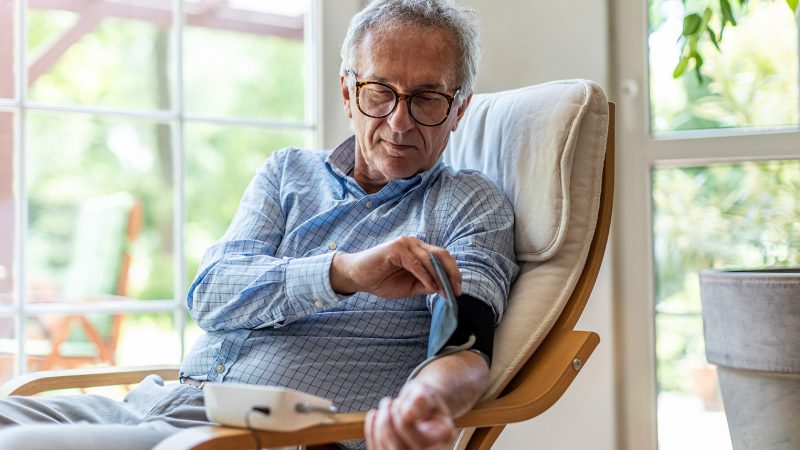Best Use of Digital in Primary Care
Surrey Heartlands scales up remote monitoring service with Inhealthcare to support 125,000 people living with high blood pressure
Surrey Heartland’s Digital Primary Care team is working with Inhealthcare to target and support around 125,900 people estimated to be living with poorly-controlled diagnosed or undiagnosed hypertension.
Blood Pressure@Home enables patients to monitor their blood pressure from the comfort of their own home, without the need to visit their GP practice. They send in BP readings digitally to a team who support them in managing their condition. The multi-disciplinary NHS team aims to support 125,900 people living with poorly-controlled hypertension in Surrey.
Building on a successful pilot in 2021, the service with Inhealthcare is led by clinical pharmacists and care coordinators working alongside GPs and other specialists. This approach, interlinked with strong patient engagement, maximises resources as the service prioritises people according to clinical need.
Studies have shown the importance of supporting patients to manage their conditions through lifestyle changes to improve health, wellbeing and satisfaction – known as patient activation. People reporting the highest levels of patient activation had fewer emergency attendances and admissions, fewer GP appointments, shorter stays when admitted for elective care and were less likely to miss appointments.
The service is designed to help patients reach the highest level to overcome inertia and work with clinicians to achieve their health goals, improve outcomes and reduce the need for unplanned care.
Patients most at risk of hospitalisation or stroke, according to a risk stratification pyramid, are actively monitored by the service using the Inhealthcare platform. The patient uses a monitor to take their BP reading and submit it to the service via a channel of their choice – an app, email, text message, or phone call – to the long-term conditions digital care coordinator, whose post, along with Inhealthcare licenses and blood pressure monitors, has been supported through NHS England funding.
Embedding strong information governance has been an essential process in developing the service, ensuring secure upload of blood pressure readings from patients to GP systems using Inhealthcare’s platform.
So far, the findings to June 2023 indicate:
- 3,161 patients from high-risk cohorts engaged with the BP@Home service between October 2021 and June 2023 and progressed through 4,031 cycles of monitoring.
- Of the 1,534 people who started with the telephone to submit their readings only 725 remain on it, representing a 53% shift towards digital channels – increasing ease and efficiency of the service and improving patients’ confidence in technology.
- 12 patients with critically high blood pressure readings in the red RAG rating were identified and through intervention by the clinical pharmacists now have readings in the green or normal threshold, preventing more serious illness and the need for hospitalisation.
- Nearly half – 46% – have been treated to target with their blood pressure readings now in the normal threshold.
- A further 1,031 (33%) patients showed improvement, with either systolic or diastolic readings showing green ratings.
- A further 50,500 responses have been submitted by patients using SMS whose blood pressure wasn’t previously known.
The integrated care system is scaling up the service across a population area of 1.1 million people, which includes an estimated 125,900 people who are living with poorly-controlled diagnosed or undiagnosed hypertension.
GP practices working together as Primary Care Networks enable a broad range of clinicians and care coordinators across a much wider geographical area to work together to deliver BP@Home as well as increase case finding of undiagnosed high blood pressure.
Hypertensive patients may see their GP twice a week; a cohort of 2,700 patients results in 5,400 appointments saved. As the service continues to scale, the savings in GP time become even more significant.
BP@Home enables patients to take charge of their own health; they can monitor their blood pressure and take readings from the comfort of their home – which also provides a better reflection of their blood pressure, as readings taken at home are more accurate than those taken in the clinic.
Mr Gurmit Bhamra, a patient on the service, summed up the benefits:
“As a result of monitoring and submitting my results, my medication has been changed, and I have also made some lifestyle changes to help manage my blood pressure better. These small changes are already helping me feel in control and have had a positive effect on reducing my blood pressure. I feel supported and encouraged to make the right decisions, and I know that there’s help at the end of the phone if I need it.”
Dr Jagjit Rai, Partner at St David’s Family Practice, Stanwell, said:
“We have demonstrated that patients are happy to monitor their condition from home, and when they do, they not only develop a better understanding but feel empowered to manage it better through remembering to take their medication and making lifestyle choices. This will lead to better preventative care for our patients and reduce the burden on GP practices as we receive the patients’ results electronically rather than having to see them each time.”
Gillian Kneale, Surrey Heartlands patient care coordinator, said:
“This is all about early intervention and picking up and identifying that there is an issue before something goes wrong. We do whatever is necessary, take whatever path that needs to be taken, in getting a patient into whatever service is required quicker than they would by their own means.”
Inhealthcare is a UK leader in digital health and remote patient monitoring. Its platform has delivered more than three million episodes of care and produced more than 150 separate digital pathways. The company’s platform automates as many processes as possible in a pathway, which means clinicians can focus their skills and energy on patients who need the most care rather than having to waste time on mundane administrative tasks.
Supporting links to further resources and materials:
HS England case study

